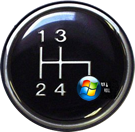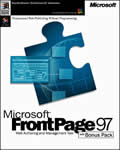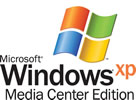Four on the floor – 4 Microsoft Products you’ve probably never used
 Over the last twenty years Microsoft has released some tremendous programs that never quite made as big an impact as they should have. They were eventually discontinued outright, incorporated into larger products, or left in “limbo” to ultimately die. According to them, in most cases the products just weren’t “selling.” What that really means is that they couldn’t sell it in a multi-user market and they are more concerned with selling multiple licenses then single ones or retail boxes.
Over the last twenty years Microsoft has released some tremendous programs that never quite made as big an impact as they should have. They were eventually discontinued outright, incorporated into larger products, or left in “limbo” to ultimately die. According to them, in most cases the products just weren’t “selling.” What that really means is that they couldn’t sell it in a multi-user market and they are more concerned with selling multiple licenses then single ones or retail boxes.
ere is a list of four products Microsoft released and then discontinued, incorporated into other products, or left in “limbo.” Some you may have heard of:
FrontPage
First introduced: 1996. Yes FrontPage. This was a beginner’s web design tool. For the Small Business this was a great value and was inexpensive, around $150. For anyone that didn’t know HTML coding or knew little about websites, this program was for you. It did a lot for helping small business owners put up quick easy websites and helped novice designers learn the basics and start their careers.
Yes FrontPage. This was a beginner’s web design tool. For the Small Business this was a great value and was inexpensive, around $150. For anyone that didn’t know HTML coding or knew little about websites, this program was for you. It did a lot for helping small business owners put up quick easy websites and helped novice designers learn the basics and start their careers.
Where is it now?
 FrontPage was eventually redesigned from the ground up and released as Expression Web Design Studio. Expression Web was a suite built to compete with, at the time, MacroMedia’s DreamWeaver Studio. The complete suite retailed for around $650. It was the first real Web Design program suite to incorporate Web Design standards based on the W3 guidelines. It was a great tool both from a developer’s point of view and for the novice.
FrontPage was eventually redesigned from the ground up and released as Expression Web Design Studio. Expression Web was a suite built to compete with, at the time, MacroMedia’s DreamWeaver Studio. The complete suite retailed for around $650. It was the first real Web Design program suite to incorporate Web Design standards based on the W3 guidelines. It was a great tool both from a developer’s point of view and for the novice.
Eventually, the Expression Suite was incorporated into the Microsoft Visual Studio Suite. While there was a Free version available; the Visual Studio version was more robust and came with a price tag ranging from $1,199 to $13,299. That’s not a typo folks!!
What happened?
It boils down to marketing. While FrontPage was a poor tool from a serious developer point of view; it really was a great tool for the novice. However, Expression Web Studio was head and shoulders above FrontPage. The potential for Expression Web giving DreamWeaver a serious run was there. But Microsoft never really has taken the small business market that seriously. As a result they never really spent a lot of time marketing it for the small web design studio or the small business owner.
Outlook with Business Contact Manager
First introduced: 2003
 If you have ever used Goldmine or ACT!, BCM puts them to shame, I have used all three. BCM is designed for tracking not simply business contacts but sales, leads, marketing and a slew of other features I won’t get into here. The features available with BCM and how seamlessly it integrates into Outlook was hands down the best Customer Relations Management system for the small business.
If you have ever used Goldmine or ACT!, BCM puts them to shame, I have used all three. BCM is designed for tracking not simply business contacts but sales, leads, marketing and a slew of other features I won’t get into here. The features available with BCM and how seamlessly it integrates into Outlook was hands down the best Customer Relations Management system for the small business.
Where is it now?
At the release of Office 2010 BCM was only available through an Open License, aka multi-user, agreement. However not long after the release, Microsoft heard the cries of BCM Fans and it is now available for free under certain conditions. The release of Office 365 (the cloud version of office) and Office 2013 have found BCM pretty much in limbo.
What happened?
Microsoft with its financial clout could have easily given both ACT! and Goldmine a hard time and brought one if not both to its knees. The product was easier to navigate, had far more features and integrated into an already well known/well used product. Add to the fact that a single BCM database could be shared by up to five (5) concurrent users, the ability to take a copy of the database on the road and then sync it to the main database and a “Mom and Pop” shop could have a “well oiled” sales staff sharing information between them. Again Microsoft never really has taken the small business market that seriously. As a result they never really marketed it for the small business owner.
Small Business Accounting
First introduced: around 2006
![]() Small Business Accounting was supposed to be Microsoft’s QuickBooks competitor. Upon first release, Microsoft was literally giving it away, one of the first products Microsoft openly gave away. While the free version had certain features locked, inventory management and a few others; the paid version was very reasonably priced, around $150. However, the free version offered enough features to allow a small business to use it for their accounting needs. Add to the fact that the paid version could be integrated into Business Contact Manager for Outlook and a small business had further reason to use these products.
Small Business Accounting was supposed to be Microsoft’s QuickBooks competitor. Upon first release, Microsoft was literally giving it away, one of the first products Microsoft openly gave away. While the free version had certain features locked, inventory management and a few others; the paid version was very reasonably priced, around $150. However, the free version offered enough features to allow a small business to use it for their accounting needs. Add to the fact that the paid version could be integrated into Business Contact Manager for Outlook and a small business had further reason to use these products.
Where is it now?
Small Business Accounting version 2009 was the last Microsoft released and it was discontinued shortly after that. While they still offer an accounting software package, I believe it is Dynamics ERP, it is sold only through a Multi-user licensing agreement.
What happened?
As mentioned before, it boils down to marketing, with Microsoft’s clout and the quality of the program. They could have brought Intuit’s QuickBooks to its knees. The Pro version with everything unlocked, was cheaper than QuickBooks. It was easier to navigate, you could import your QuickBooks file and its ease of integration with the rest of the Office Suite made it a far more appealing product for the small business. Yet Microsoft did little to no marketing for it. It’s a shame really; I’m still using Small Business Accounting Professional 2008 and have no intention of switching to QuickBooks any time soon.
Windows Media Center
First introduced: Sept. 2002
 Windows Media Center started out as a less expensive alternative to Windows XP Home. While it was basically Windows XP Home, the interface was very different from XP; there was no desktop and you had a single screen that allowed you to scroll through your choices of what you wanted to do.
Windows Media Center started out as a less expensive alternative to Windows XP Home. While it was basically Windows XP Home, the interface was very different from XP; there was no desktop and you had a single screen that allowed you to scroll through your choices of what you wanted to do.
WMC offered users a rich, easy to navigate interface for organizing pictures, music and other media. As time went on you had the ability to watch online movies through the NetFlix plug-in. Add a TV/Cable card or FM tuner, and you could watch live TV or listen to radio through it.
Where is it now?
Windows Media Center was incorporated into the next release of Windows; Windows Vista and subsequently Windows 7. At the release of Windows 8, Windows Media Center is not included with the Operating system and is now an “Add-on pack” that can be downloaded. With this omission I see WMC going the way of the Dodo.
What Happened?
That’s a tough question to answer because although Microsoft was very forward thinking in implementing WMC very early, they just never seemed to know quite what to do with it. The potential for WMC was tremendous. If Microsoft had really understood how ahead of the game they were when they released it and began to build more partnerships with online content providers besides NetFlix. WMC could have been the greatest consumer selling point for Windows 7 and Windows 8 than any other operating system on the market. Had they included WMC with Windows 8 it could have been the main portal for providers such as Hulu, Netflix, HBO, ShowTime and Cable providers. Not to mention, radio, YouTube and other online content providers.
These four programs could have easily been far greater money makers for Microsoft had they really understood the market these products were best suited for. Unfortunately, Microsoft seems to view the average consumer and the true small business as a “secondary” income. Oh how things have changed.





